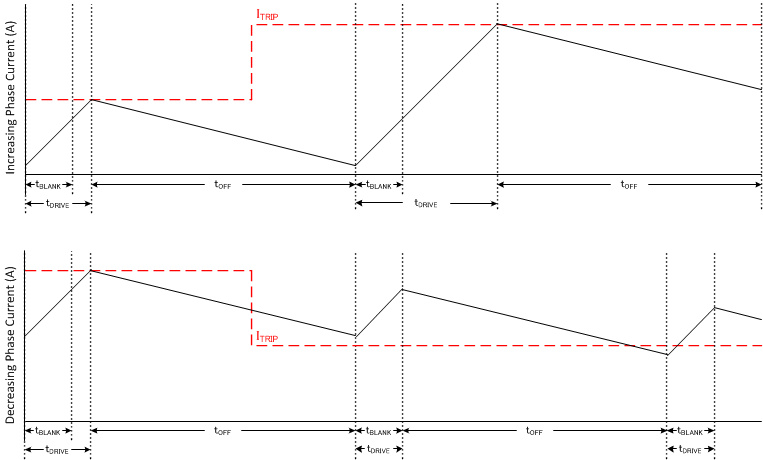SLOSE47A November 2020 – May 2022 DRV8434
PRODUCTION DATA
- 1 Features
- 2 Applications
- 3 Description
- 4 Revision History
- 5 Pin Configuration and Functions
- 6 Specifications
-
7 Detailed Description
- 7.1 Overview
- 7.2 Functional Block Diagram
- 7.3
Feature Description
- 7.3.1 Stepper Motor Driver Current Ratings
- 7.3.2 PWM Motor Drivers
- 7.3.3 Microstepping Indexer
- 7.3.4 Controlling VREF with an MCU DAC
- 7.3.5 Current Regulation
- 7.3.6
Decay Modes
- 7.3.6.1 Slow Decay for Increasing and Decreasing Current
- 7.3.6.2 Slow Decay for Increasing Current, Mixed Decay for Decreasing Current
- 7.3.6.3 Mixed Decay for Increasing and Decreasing Current
- 7.3.6.4 Smart tune Dynamic Decay
- 7.3.6.5 Smart tune Ripple Control
- 7.3.6.6 PWM OFF Time
- 7.3.6.7 Blanking time
- 7.3.7 Charge Pump
- 7.3.8 Linear Voltage Regulators
- 7.3.9 Logic Level, Tri-Level and Quad-Level Pin Diagrams
- 7.3.10 Protection Circuits
- 7.4 Device Functional Modes
- 8 Application and Implementation
- 9 Power Supply Recommendations
- 10Layout
- 11Device and Documentation Support
- 12Mechanical, Packaging, and Orderable Information
Package Options
Mechanical Data (Package|Pins)
Thermal pad, mechanical data (Package|Pins)
- RGE|24
Orderable Information
7.3.6.1 Slow Decay for Increasing and Decreasing Current
 Figure 7-8 Slow/Slow Decay Mode
Figure 7-8 Slow/Slow Decay ModeDuring slow decay, both low-side MOSFETs of the H-bridge are turned on, allowing the current to be recirculated.
Slow decay exhibits the least current ripple of the decay modes for a given tOFF. However on decreasing current steps, slow decay will take a long time to settle to the new ITRIP level because the current decreases very slowly. If the current at the end of the off time is above the ITRIP level, slow decay will be extended for multiple off time duration, until the current at the end of the cumulative off time is below the ITRIP level.
When the winding current is held static for a long time (for example while no STEP input is present), or at very low step rates, slow decay may not properly regulate the current because back-EMF will be small or absent across the motor windings. The motor current can rise rapidly, and may require an extremely long off-time. In some cases this could result in loss of current regulation. An aggressive decay mode is recommended in such cases.